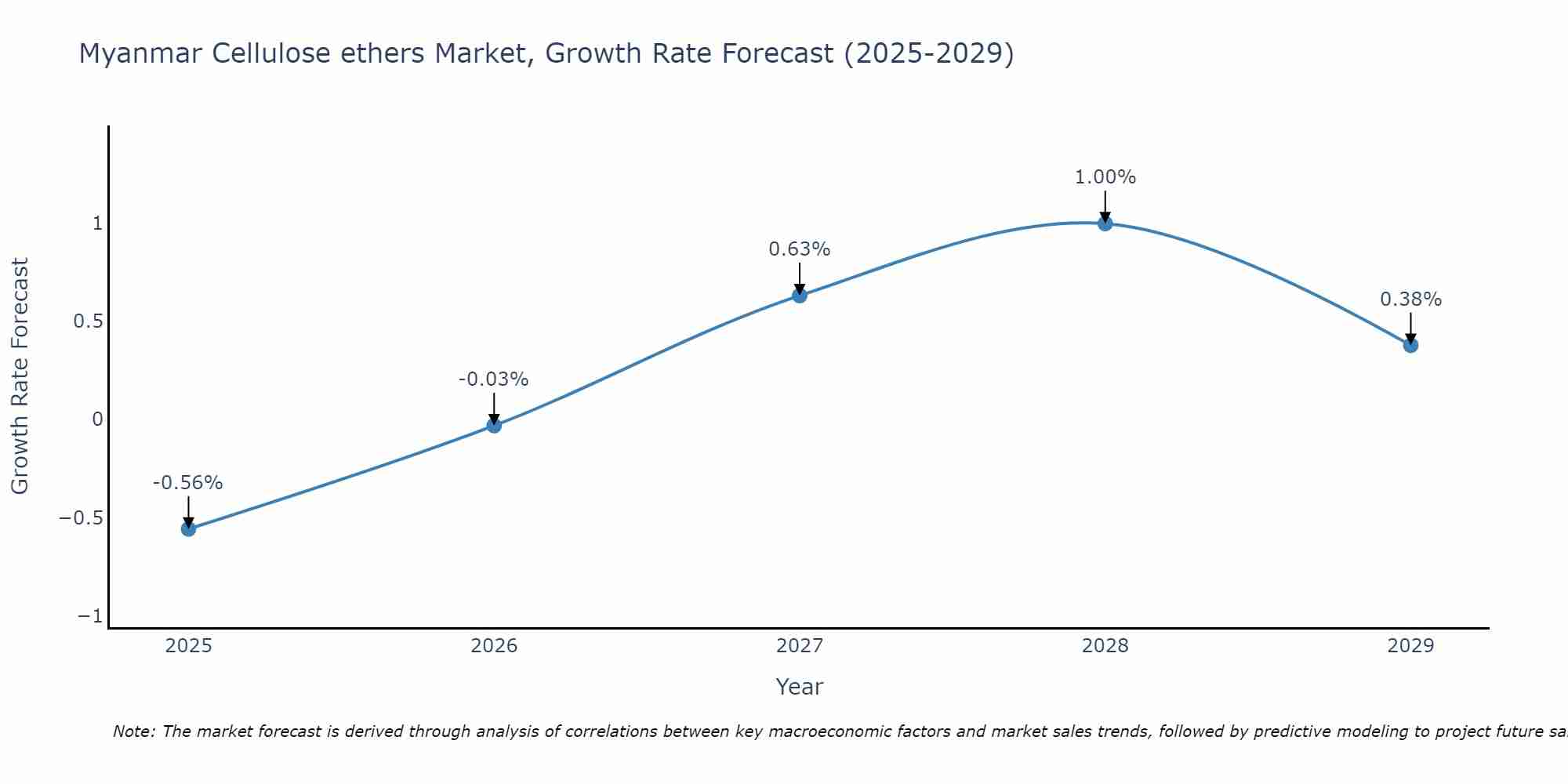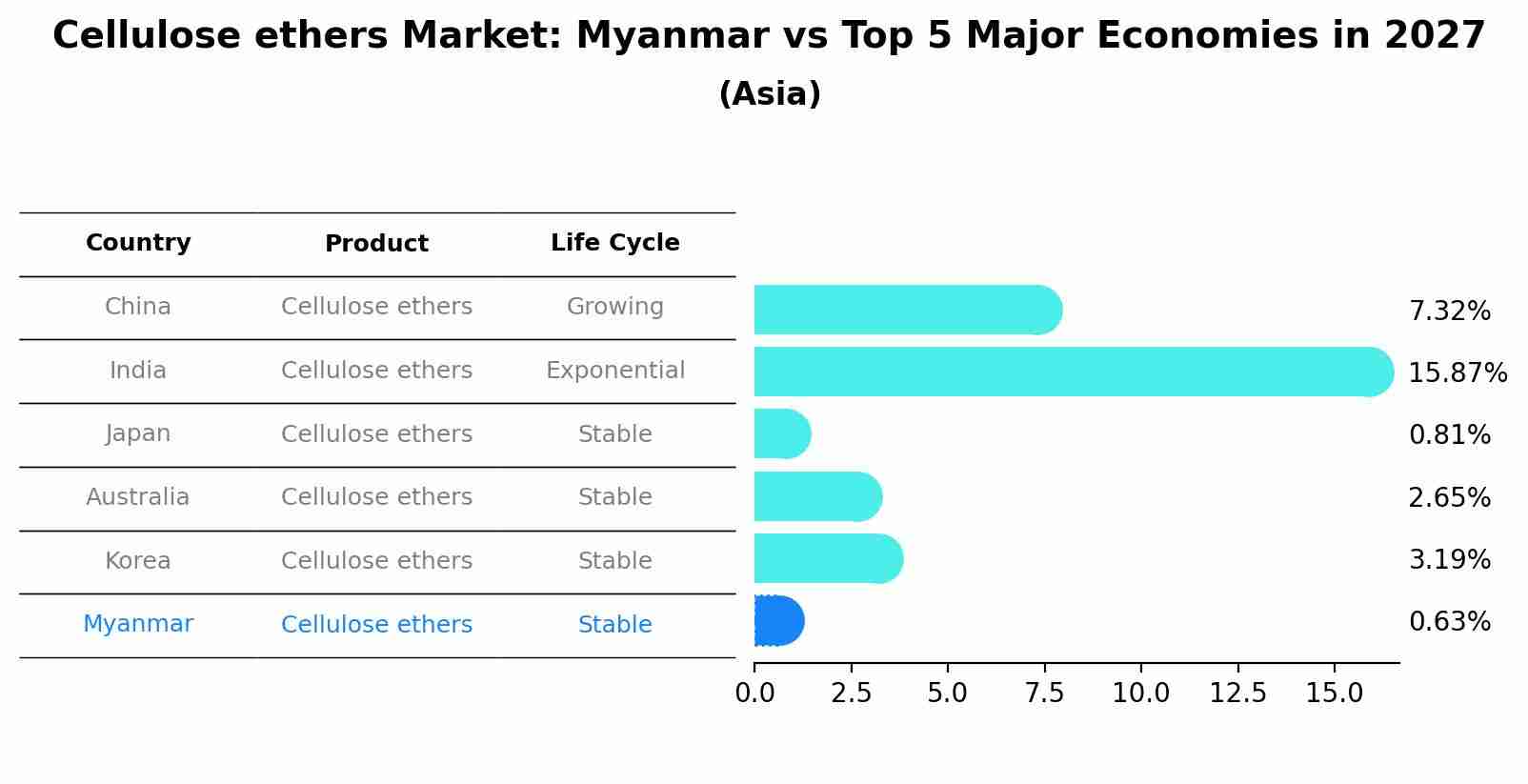Myanmar Cellulose ethers Market (2025-2031) Outlook | Analysis, Share, Industry, Size, Growth, Value, Trends, Forecast, Companies & Revenue
| Product Code: ETC093053 | Publication Date: Jun 2021 | Updated Date: Apr 2025 | Product Type: Report | |
| Publisher: 6Wresearch | Author: Ravi Bhandari | No. of Pages: 70 | No. of Figures: 35 | No. of Tables: 5 |
Myanmar Cellulose ethers Market Size Growth Rate
The Myanmar Cellulose ethers Market is projected to witness mixed growth rate patterns during 2025 to 2029. Starting at -0.56% in 2025, the market peaks at 1.00% in 2028, and settles at 0.38% by 2029.

Cellulose ethers Market: Myanmar vs Top 5 Major Economies in 2027 (Asia)
The Cellulose ethers market in Myanmar is projected to grow at a stable growth rate of 0.63% by 2027, within the Asia region led by China, along with other countries like India, Japan, Australia and South Korea, collectively shaping a dynamic and evolving market environment driven by innovation and increasing adoption of emerging technologies.

Myanmar Cellulose ethers Market Overview
The Myanmar Cellulose Ethers Market is experiencing significant growth supported by the construction, pharmaceutical, and food industries. Cellulose ethers are widely used as thickeners, stabilizers, and binders in various applications such as paints, cosmetics, pharmaceutical formulations, and food products. With the expanding construction sector and growing demand for pharmaceuticals and processed foods in Myanmar, the market for cellulose ethers is poised for continued expansion.
Drivers of the market
The demand for cellulose ethers in Myanmar is driven by their application in the construction, pharmaceutical, and food industries. In construction, they are used as additives in cement and plasters for improved workability and water retention. The pharmaceutical sector utilizes cellulose ethers as binders and stabilizers in drug formulations. The growing population and urbanization are increasing construction activities and pharmaceutical consumption, thereby driving the market for cellulose ethers.
Challenges of the market
In the Myanmar cellulose ethers market, a significant challenge is the limited availability of high-quality raw materials and the dependence on imports for certain types of cellulose ethers. This can lead to supply chain disruptions and price fluctuations, impacting the profitability of manufacturers. Investing in research and development to find alternative sources or improve production processes could help mitigate these challenges.
Government Policy of the market
In Myanmar, government policies regarding the cellulose ethers market focus on quality control, safety standards, and environmental sustainability. Regulatory agencies establish guidelines for the production, import, and use of cellulose ethers in industries such as construction, food, and personal care. These regulations may include specifications for product purity, labeling requirements, and permissible additives to ensure consumer safety and product efficacy. Additionally, the government may support research and development initiatives to promote innovation in cellulose ethers technology and encourage the adoption of greener alternatives that minimize environmental impact and address emerging market demands.
Key Highlights of the Report:
- Myanmar Cellulose ethers Market Outlook
- Market Size of Myanmar Cellulose ethers Market, 2024
- Forecast of Myanmar Cellulose ethers Market, 2031
- Historical Data and Forecast of Myanmar Cellulose ethers Revenues & Volume for the Period 2021-2031
- Myanmar Cellulose ethers Market Trend Evolution
- Myanmar Cellulose ethers Market Drivers and Challenges
- Myanmar Cellulose ethers Price Trends
- Myanmar Cellulose ethers Porter's Five Forces
- Myanmar Cellulose ethers Industry Life Cycle
- Historical Data and Forecast of Myanmar Cellulose ethers Market Revenues & Volume By Product Type for the Period 2021-2031
- Historical Data and Forecast of Myanmar Cellulose ethers Market Revenues & Volume By Carboxymethyl Cellulose for the Period 2021-2031
- Historical Data and Forecast of Myanmar Cellulose ethers Market Revenues & Volume By Methyl Cellulose & Derivatives for the Period 2021-2031
- Historical Data and Forecast of Myanmar Cellulose ethers Market Revenues & Volume By Hydroxyethyl Cellulose for the Period 2021-2031
- Historical Data and Forecast of Myanmar Cellulose ethers Market Revenues & Volume By Others for the Period 2021-2031
- Historical Data and Forecast of Myanmar Cellulose ethers Market Revenues & Volume By Application for the Period 2021-2031
- Historical Data and Forecast of Myanmar Cellulose ethers Market Revenues & Volume By Food and Beverage for the Period 2021-2031
- Historical Data and Forecast of Myanmar Cellulose ethers Market Revenues & Volume By Pharmaceuticals and Healthcare for the Period 2021-2031
- Historical Data and Forecast of Myanmar Cellulose ethers Market Revenues & Volume By Construction for the Period 2021-2031
- Historical Data and Forecast of Myanmar Cellulose ethers Market Revenues & Volume By Cosmetics for the Period 2021-2031
- Historical Data and Forecast of Myanmar Cellulose ethers Market Revenues & Volume By Personal Care for the Period 2021-2031
- Historical Data and Forecast of Myanmar Cellulose ethers Market Revenues & Volume By Others for the Period 2021-2031
- Myanmar Cellulose ethers Import Export Trade Statistics
- Market Opportunity Assessment By Product Type
- Market Opportunity Assessment By Application
- Myanmar Cellulose ethers Top Companies Market Share
- Myanmar Cellulose ethers Competitive Benchmarking By Technical and Operational Parameters
- Myanmar Cellulose ethers Company Profiles
- Myanmar Cellulose ethers Key Strategic Recommendations
Frequently Asked Questions About the Market Study (FAQs):
1 Executive Summary |
2 Introduction |
2.1 Key Highlights of the Report |
2.2 Report Description |
2.3 Market Scope & Segmentation |
2.4 Research Methodology |
2.5 Assumptions |
3 Myanmar Cellulose ethers Market Overview |
3.1 Myanmar Country Macro Economic Indicators |
3.2 Myanmar Cellulose ethers Market Revenues & Volume, 2021 & 2031F |
3.3 Myanmar Cellulose ethers Market - Industry Life Cycle |
3.4 Myanmar Cellulose ethers Market - Porter's Five Forces |
3.5 Myanmar Cellulose ethers Market Revenues & Volume Share, By Product Type, 2021 & 2031F |
3.6 Myanmar Cellulose ethers Market Revenues & Volume Share, By Form, 2021 & 2031F |
4 Myanmar Cellulose ethers Market Dynamics |
4.1 Impact Analysis |
4.2 Market Drivers |
4.3 Market Restraints |
5 Myanmar Cellulose ethers Market Trends |
6 Myanmar Cellulose ethers Market, By Types |
6.1 Myanmar Cellulose ethers Market, By Product Type |
6.1.1 Overview and Analysis |
6.1.2 Myanmar Cellulose ethers Market Revenues & Volume, By Product Type, 2021-2031F |
6.1.3 Myanmar Cellulose ethers Market Revenues & Volume, By Carboxymethyl Cellulose, 2021-2031F |
6.1.4 Myanmar Cellulose ethers Market Revenues & Volume, By Methyl Cellulose & Derivatives, 2021-2031F |
6.1.5 Myanmar Cellulose ethers Market Revenues & Volume, By Hydroxyethyl Cellulose, 2021-2031F |
6.1.6 Myanmar Cellulose ethers Market Revenues & Volume, By Others, 2021-2031F |
6.2 Myanmar Cellulose ethers Market, By Application |
6.2.1 Overview and Analysis |
6.2.2 Myanmar Cellulose ethers Market Revenues & Volume, By Food and Beverage, 2021-2031F |
6.2.3 Myanmar Cellulose ethers Market Revenues & Volume, By Pharmaceuticals and Healthcare, 2021-2031F |
6.2.4 Myanmar Cellulose ethers Market Revenues & Volume, By Construction, 2021-2031F |
6.2.5 Myanmar Cellulose ethers Market Revenues & Volume, By Cosmetics, 2021-2031F |
6.2.6 Myanmar Cellulose ethers Market Revenues & Volume, By Personal Care, 2021-2031F |
6.2.7 Myanmar Cellulose ethers Market Revenues & Volume, By Others, 2021-2031F |
7 Myanmar Cellulose ethers Market Import-Export Trade Statistics |
7.1 Myanmar Cellulose ethers Market Export to Major Countries |
7.2 Myanmar Cellulose ethers Market Imports from Major Countries |
8 Myanmar Cellulose ethers Market Key Performance Indicators |
9 Myanmar Cellulose ethers Market - Opportunity Assessment |
9.1 Myanmar Cellulose ethers Market Opportunity Assessment, By Product Type, 2021 & 2031F |
9.2 Myanmar Cellulose ethers Market Opportunity Assessment, By Application, 2021 & 2031F |
10 Myanmar Cellulose ethers Market - Competitive Landscape |
10.1 Myanmar Cellulose ethers Market Revenue Share, By Companies, 2024 |
10.2 Myanmar Cellulose ethers Market Competitive Benchmarking, By Operating and Technical Parameters |
11 Company Profiles |
12 Recommendations |
13 Disclaimer |
- Single User License$ 1,995
- Department License$ 2,400
- Site License$ 3,120
- Global License$ 3,795
Search
Related Reports
- ASEAN Bearings Market (2025-2031) | Strategy, Consumer Insights, Analysis, Investment Trends, Opportunities, Growth, Size, Share, Industry, Revenue, Segments, Value, Segmentation, Supply, Forecast, Restraints, Outlook, Competition, Drivers, Trends, Demand, Pricing Analysis, Competitive, Strategic Insights, Companies, Challenges
- Europe Flooring Market (2025-2031) | Outlook, Share, Industry, Trends, Forecast, Companies, Revenue, Size, Analysis, Growth & Value
- Saudi Arabia Manlift Market (2025-2031) | Outlook, Size, Growth, Trends, Companies, Industry, Revenue, Value, Share, Forecast & Analysis
- Uganda Excavator, Crane, and Wheel Loaders Market (2025-2031) | Strategy, Consumer Insights, Analysis, Investment Trends, Opportunities, Growth, Size, Share, Industry, Revenue, Segments, Value, Segmentation, Supply, Forecast, Restraints, Outlook, Competition, Drivers, Trends, Demand, Pricing Analysis, Competitive, Strategic Insights, Companies, Challenges
- Rwanda Excavator, Crane, and Wheel Loaders Market (2025-2031) | Strategy, Consumer Insights, Analysis, Investment Trends, Opportunities, Growth, Size, Share, Industry, Revenue, Segments, Value, Segmentation, Supply, Forecast, Restraints, Outlook, Competition, Drivers, Trends, Demand, Pricing Analysis, Competitive, Strategic Insights, Companies, Challenges
- Kenya Excavator, Crane, and Wheel Loaders Market (2025-2031) | Strategy, Consumer Insights, Analysis, Investment Trends, Opportunities, Growth, Size, Share, Industry, Revenue, Segments, Value, Segmentation, Supply, Forecast, Restraints, Outlook, Competition, Drivers, Trends, Demand, Pricing Analysis, Competitive, Strategic Insights, Companies, Challenges
- Angola Excavator, Crane, and Wheel Loaders Market (2025-2031) | Strategy, Consumer Insights, Analysis, Investment Trends, Opportunities, Growth, Size, Share, Industry, Revenue, Segments, Value, Segmentation, Supply, Forecast, Restraints, Outlook, Competition, Drivers, Trends, Demand, Pricing Analysis, Competitive, Strategic Insights, Companies, Challenges
- Israel Intelligent Transport System Market (2025-2031) | Strategy, Consumer Insights, Analysis, Investment Trends, Opportunities, Growth, Size, Share, Industry, Revenue, Segments, Value, Segmentation, Supply, Forecast, Restraints, Outlook, Competition, Drivers, Trends, Demand, Pricing Analysis, Competitive, Strategic Insights, Companies, Challenges
- Uganda Precast and Aggregate Market (2025-2031) | Strategy, Consumer Insights, Analysis, Investment Trends, Opportunities, Growth, Size, Share, Industry, Revenue, Segments, Value, Segmentation, Supply, Forecast, Restraints, Outlook, Competition, Drivers, Trends, Demand, Pricing Analysis, Competitive, Strategic Insights, Companies, Challenges
- Australia IT Asset Disposal Market (2025-2031) | Strategy, Consumer Insights, Analysis, Investment Trends, Opportunities, Growth, Size, Share, Industry, Revenue, Segments, Value, Segmentation, Supply, Forecast, Restraints, Outlook, Competition, Drivers, Trends, Demand, Pricing Analysis, Competitive, Strategic Insights, Companies, Challenges
Industry Events and Analyst Meet
Our Clients
Whitepaper
- Middle East & Africa Commercial Security Market Click here to view more.
- Middle East & Africa Fire Safety Systems & Equipment Market Click here to view more.
- GCC Drone Market Click here to view more.
- Middle East Lighting Fixture Market Click here to view more.
- GCC Physical & Perimeter Security Market Click here to view more.
6WResearch In News
- Doha a strategic location for EV manufacturing hub: IPA Qatar
- Demand for luxury TVs surging in the GCC, says Samsung
- Empowering Growth: The Thriving Journey of Bangladesh’s Cable Industry
- Demand for luxury TVs surging in the GCC, says Samsung
- Video call with a traditional healer? Once unthinkable, it’s now common in South Africa
- Intelligent Buildings To Smooth GCC’s Path To Net Zero













